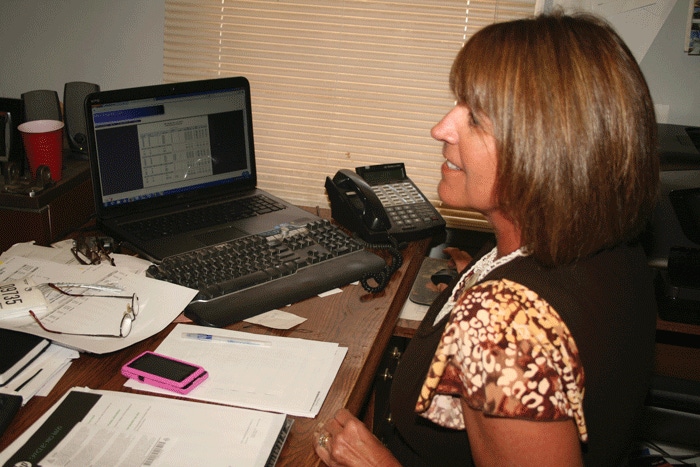July 23, 2012

These days it seems there is an app for most everything and modern day agriculture is no different. For sure with cotton: There’s an app for that!
As Emporia, Va., cotton ginner Mark Hodges and his wife Karan found out last year, an app for tracking cotton modules can make life a little easier around the gin come fall picking time.
During the fall of the year things get so busy at Mid-Atlantic cotton gin that Mark and Karan stay on-site at the gin in a travel trailer, rather than making the 25 mile trip each way to and from their home.
Karan, who is office manager for the gin, says as she was paying bills last year a flyer for a new cell phone app caught her eye. The bill was from EWR, the company that provides Mid-Atlantic’s eCotton-brand gin software and a service called CottonHost, a website that provides reporting of gin data to farmers.
“Normally that kind of paper goes straight to the trash can, but something about it caught my eye — just serendipity, I guess. After reading it, I knew I had the perfect candidate to give the smart phone-based program a test,” she recalls.
The guinea pig for the smart phone app for cotton is Mark and Karan’s son, Jason, who now farms nearly 1,000 acres of cotton in nearby Drewryville, Va. Jason, who worked at the gin prior to starting his own farming operation a few years back, took the new app and put it to use tracking his modules.
“We have a number of younger farmers, who grew up with computers and Internet technology who use the app and really like it. In fact, all our growers who have taken the time to figure out how to use it, really like it,” Karan says.
“The App can now be used on Android devices and IPhones, which most of our farmers have. The MyModules app only costs $10, and we will help our growers buy it and set it up on their phone,” she adds.
There is no doubt the coming of cotton modules and more recently cotton pickers that pick and bale cotton on the same machine have made cotton harvest much less labor intensive and more efficient. Compressing cotton picking and ginning into a tighter time span has also created many challenges for both growers and ginners.
“There is now an app for most anything you want to do in life,” says Raleigh-based computer programmer Shawn Lipscomb, who helped build the MyModules app.
Built for cotton harvesting, ginning
“We’ve used a number of the principles involved in building apps and applied them to cotton, and more specifically to cotton harvesting and ginning,” Lipscomb says.
MyModules has two sides, says Lipscomb, who is general manager of EWR, Inc. First, the farmer can enter basic information, like when the module is made, where it’s located and what its ID number is directly into their phone and transmit this information instantly to the gin.
The second side of the app provides for tracking the progress of registered modules, from transmission, to pick-up, to ginning, to bale information.
Without using the app, module registration is typically done by calling the gin and giving them the registration number and other information about a module. With dozens of growers calling in numbers, the chance for human error is high. “As long as the correct numbers are entered into the MyModules app, human error is greatly reduced,” Lipscomb stresses.
Using the drop down choices on the app, a grower can add things like which producer account the module is assigned to, which farm or field the module came from. This information doesn’t have to be entered, the grower can choose from a pre-prepared list of options on their phone.
“The grower has four options for entering module information, depending on what level of detail their gin wants to receive: alphanumeric module IDs, numeric module IDs, simple number of modules with no IDs, or a sequence of numeric module IDs, for example that runs from 35001 through 35012," Lipscomb explains.
"It also allows the grower to push a button to activate the barcode reader, which uses the phone's camera to scan the barcode on the module ticket attached to the module instead of manually keying in the module ID," he adds.
Helping eliminate the human errors that occur despite the best efforts of growers and ginners, is a big advantage for the MyModules app, Mark Hodges says. “We have an excellent internal tracking system at our gin, and we are confident once we get a bale of cotton in the gin, we will know where it is and all the information about it that we need to know,” he adds.
“Despite this system and having a very good rapport with our growers, when they get busy and we get busy, it’s easy to write down a module number wrong or for the grower to give us a number with two numbers flip-flopped. If used correctly, this new smart phone ap can virtually eliminate those kind of human errors, “Mark says.
To use the MyModule app, growers must work with a cotton gin that subscribes to CottonHost. For the MyModules app, CottonHost is used as the communication backbone, Lipscomb explains. The app communicates with the Cotton Host server, because the site and communication link already exists, the data goes directly to the gin.
The app allows the grower to network multiple crews, working in different locations. He can even see a summary and listing of all modules from all crews on his smartphone.
Eliminates human error
This allows him to enter multiple modules and eliminates human error that often occurs when a busy worker is trying to write down the correct combination of letters and numbers that identify the module.
From the ginner’s perspective, the app allows him to track where modules are located and more efficiently arrange work crews to pick up the bales. If need be, the ginner could go back and determine from which module a particular bale of cotton came.
The MyModules app itself grabs the GPS coordinates for each individual module (when modules are registered as they are made in the field). The grower doesn't need to send driving directions to the gin. Instead, the gin's module truck drivers could use the Google Maps app (or MapQuest) on their own smartphones to get driving directions, or even use Google Navigation to get real-time turn-by-turn directions.
Also, because the gin gets the GPS coordinates in the data that comes from MyModules, the gin can print out Google Maps and/or driving directions from the eCotton Gin System for the drivers to use.
Lipscomb, who communicates regularly with dozens of gins throughout the Southeast, says the reception by growers to the new app has been outstanding. “Based on the feedback we are getting from ginners, we expect a lot more farmers will be using MyModules this fall,” he says.
Lipscomb says there are apps for gins to monitor bale moisture and other factors.
For growers there are apps to track insurance factors, irrigation tracking apps, market tracking apps and apps for determining which chemicals can and can’t be mixed. In short, he says, with cotton, there’s an app for that.
The latest app released this summer is an upgrade to MyModules. It provides three new features: 1.) the grower can see the location of a given module on an interactive map; 2.) robust support for custom pickers, who can register new modules for a farmer after being authorized, but the "tracking of the progress of registered modules" features are hidden; and 3.) significant performance (speed) improvements.
Though developed for tracking cotton modules, the new app may become even more valuable as more and more growers move toward having their cotton custom picked with one of the on-board module-building pickers.
The cotton baled by either a John Deere or Case IH picker is usually called a bale by growers, in reality it is just a small-sized ‘mini’ module, Lipscomb explains.
Using MyModules, Mark Hodges says, keeping track of these smaller modules, dropped in a field by one of the new onboard module-building cotton pickers is not much more difficult than keeping up with standard size modules, which typically hold four of the big round cotton ‘mini’ modules.
The grower still has a module number, and the big, round bales become subsets under that module number. You would have, module 2550, for example and the bales would be 2550-1, 2550-2 etc. he explains.
Lipscomb says there are two ways gins track bales generated by on-board module builders. The first is the way Mark and Karan are doing it. However, the app can be used to track each individual mini module generated by a Deere or Case IH on-board module builder. Both ways work fine, Lipscomb says, it’s just a matter of how the gin is set up and how they want to number and track these bales.
Mark and Karan Hodges agree that last year was a learning experience with the MyModules app, and how widely it will be used this year in uncertain.
“When we got CottonHost several years back, I thought a few people might use it, but I didn’t think many farmers would be interested. I was wrong! Our farmers do like it and do use it,” Mark Hodges says.
About the Author(s)
You May Also Like






